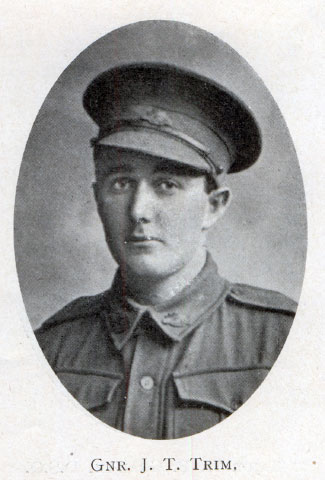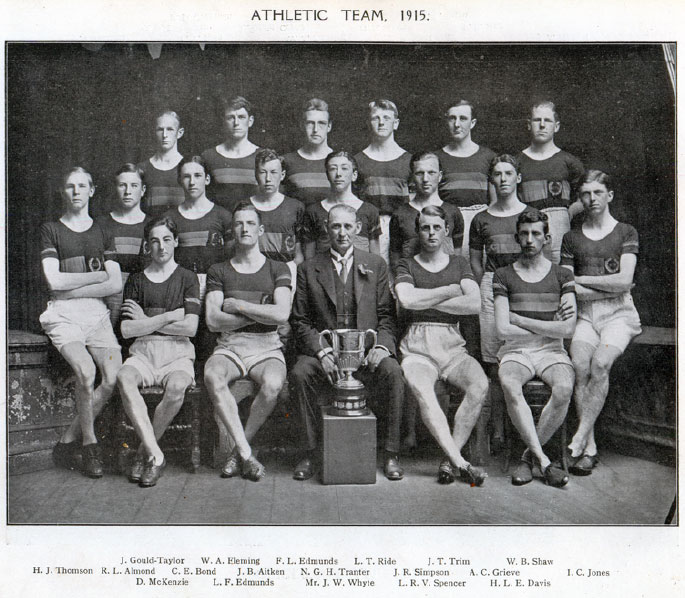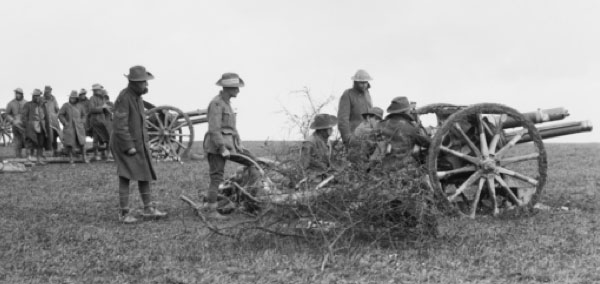War Memorial Hall c1929

John Thomas TRIM

John ‘Jack’ Trim was born on 1 February 1896 in Benalla, Victoria. His parents were John Thomas and Alice (née Ryan) Trim. He attended Scotch from 1912 to 1915. Jack’s parents were from Wagga Wagga, and he was a boarder. Jack was a Prefect in 1915. He represented the school in the 1914 and 1915 Athletics teams, both of which won their competitions. He also played for the First XVIII in football in both of those years: The Scotch Collegian called him ‘a sterling half-back’. He was a fine swimmer too, winning the 100 Yards Open Handicap at the Swimming Sports in 1914 and 1915. The school Register says he won the ‘most popular boy in the school’ prize. His obituary in The Scotch Collegian said ‘Jack Trim always played the game clean. He was a fine swimmer, an excellent half-back, and a tower of strength to the boarding school as a prefect. Those who came in contact with him in the upper school admired his straightforwardness and manliness.'.
John was a student when he enlisted on 5 September 1916 in Melbourne, Victoria. He served in the 8th Field Artillery Brigade with the rank of Gunner. His Regimental Number was 31477.
John died on 30 March 1918 at Doullens, France. He was 22 years of age.
Service record
Jack had already been in the Citizen Forces when he enlisted in the AIF at age 19. He was allotted as a Gunner to the 21st Howitzer Brigade Reinforcements. He departed Melbourne in December 1916, arriving at Plymouth, England on 17 February 1917. He was training on Salisbury Plain until August, when he proceeded to France. There he was allotted to the 3rd Divisional Ammunition Column and then on 15 August to the 8th Field Artillery Brigade, part of General Monash’s 3rd Division. Jack fell ill with influenza in September, and was hospitalized at St Omer on 9 September. He did not rejoin his unit for 16 days, but was involved in the 3rd Battle of Ypres.
A comrade wrote home later that on 23 March 1918 the unit was ‘in reserve behind the lines, and were playing a football match, in which Jack was taking part, when the game was suddenly stopped, and we were ordered to go on the march.’ This was due to the major German counter-offensive of that month, which threatened to win the war for Germany. The artillery brigade war diary told that on 30 March the unit helped force back seven waves of enemy attackers. Jack’s mate continued in his letter that ‘a shell burst some distance from us, and Jack, when he was hit, fell right across the trail of the gun.When the stretcher-bearers came for him, he said, "Good-bye boys, I’m done; keep on putting them over to him.”’
An even more dramatic and informative account appeared in a letter from another of Jack’s unit mates, Acting Bombardier Victor Wootten. He wrote: ‘Jack was a great boy, and was universally liked. He met his end as an Aussie should, and I can say no more to prove that he was a man. On the flank of Villers-Bretonneux [site of one of Australia’s greatest battles, and of the main memorial to Australian war dead on the Western Front, though actually some 40 kilometres from Jack’s place of death], and in the first attempt Fritz made to take it, we were further forward with the guns than usual, and when the battle began, were soon noticed by Fritz, who, by shelling and gassing, did everything he could to shift us. Our gun was on the flank of the battery, and Fritz paid a good deal of attention to it…When things were easing off, and we had beaten the enemy back, a shell landed 20 or 30 yards away, and hit Jack and the corporal with us. At the time we were setting fuses and loading the gun. Jack was hit between the shoulders by a piece about the size of half-a-crown [a little over 1 cm in diameter]. When I picked him up, he said, “I’m done; it’s on the spine; but I’m not going to throw the towel in.” After we had placed him on a blanket under some shelter, he ordered me away to fight on, and every time I had a minute to spare, I went to him, and each time his order was the same: “Fight on; there’s infantry depending on you in front.” Three-quarters of an hour later the stretcher arrived. When he reached the dressing station, he was full of apologies for causing inconvenience to the bearers.’ He concluded that ‘I earnestly hope that, if ever I get mine, I am able to bear myself as well as Jack Trim did.’ Sadly, Victor Wootten would ‘get his’, on 20 October 1918.
As to the official words on Jack Trim’s death, the records show that on 30 March 1918, at Doullens, France, he received a penetrating gunshot wound to the chest and was taken via 11th Australian Field Ambulance to the 3rd Canadian Stationary Hospital. The Officer Commanding the Hospital later wrote that Jack ‘died immediately after admission.’ He was then buried with full military honours. His obituary in The Scotch Collegian said ‘The school mourns the death of one whom it is proud to have counted in its number.’
John Trim is buried in the Doullens Communal Cemetery Extension No. 1 (Plot VI, Row G, Grave No. 39), France.
Photographs and Documents:

Jack Trim is second from the right in the back row of this photograph of the victorious 1915 Scotch Athletics team. Jack Gould-Taylor would also be killed in 1918.

Jack Trim is at the far left of this photo of a battery of the 3rd Australian Divisional Artillery established near Vaux-sur-Somme on 29 March 1918. Jack would be killed the following day, while the two gunners next to him would be killed later in1918 (AWM E01864). Vic Wootten, in the letter quoted above, said that in the action in which Jack was killed, their gun was on the flank of the battery: that is one the extreme end of the unit’s six guns.

From an appendix to the 8th Field Artillery Brigade
Sources:
- Australian War Memorial – Roll of Honour; Red Cross Wounded and Missing file; 8th Field Artillery Brigade War Diary for March 1918
- Mishura Scotch Database
- National Archives of Australia – B2455, TRIM JOHN THOMAS
- Scotch Collegian 1918
- The AIF Project - https://www.aif.adfa.edu.au/showPerson?pid=304604


